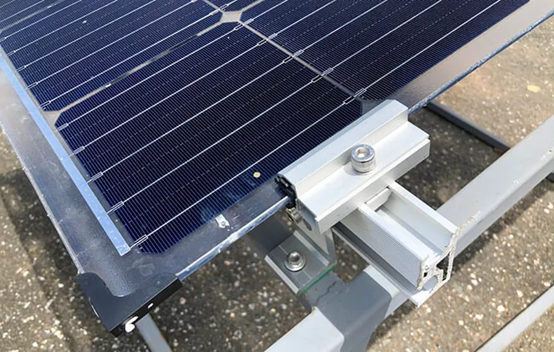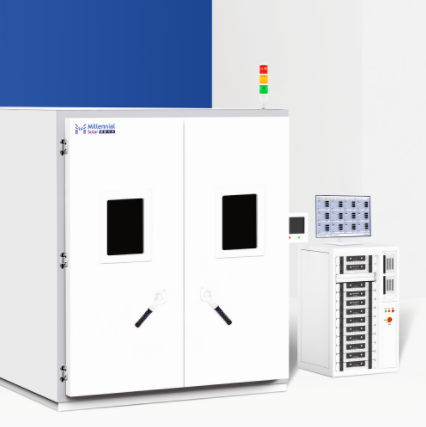
Quantum Efficiency Tester
PL/EL Integrated System
PV-Reflectumeter
3D Confocal Microscope
In-Line Four Point Probe Tester
Four Point Probe Tester
In-Line Thin Film Thickness Tester
Raman Spectrometer
FTIR Spectrometer
Spectrophotometer
Automatic Spectroscopic Ellipsometer
Contact Resistance Tester
Ultra depth of field 3D microscope
Auto Visual Tester
VMM PV Vision Measuring Machine
Solar Cell Horizontal Tensile Tester
Steady State Solar Simulator for Solar Cell
Solar Cell UV Aging Test Chamber
Solar Cell Comprehensive Tensile Tester
Visual Inspection Tester
Wet Leakage Current Tester
PV Module EL Tester
PV Module UV Preconditioning Chamber
Steady State Solar Simulator for PV Module
Current Continuous Monitor
Potential Induced Degradation Test
Bypass Diode Tester
LeTID Test System
Reverse Current Overload Tester
Impulse Voltage Tester
Hipot Insulation Tester
Ground Continuity Tester
Hipot Insulation Ground Tester
Damp Heat Test Chamber
Humidity Freeze Test
Thermal Cycle Test Chamber
Dynamic Mechanical Load Tester
Static Mechanical Load Tester
Hail Impact Tester
Robustness of Termination Tester
Module Breakage Tester
Cut Susceptibility Tester
Peel Shear Strength Tester
Universal Testing Machine (Single-arm)
Universal Testing Machine (Double-arm)
Glass Transmittance Tester
Acetic Acid Test Chamber
EVA Degree of Crosslinking Test System
Junction Box Comprehensive Tester
Drop ball tester
Semi-automatic scanning four-probe tester
Stylus Profilometer
Maximum Power Point Tracker
Perovskite Glass Transmittance Tester
Perovskite P1 Laser Scribing Multifunctional Testing Machine
Perovskite Online PL Tester
Perovskite Online Sheet Resistance Tester
Online Perovskite Film Thickness Tester
Perovskite Process Inspection Workstation
Portable IV Curve Tester
Portable EL Tester
Portable Thermal Imaging Tester
Solar Module Multi-Channel Testing System
PV Inverter Power Quality Tester
Drone EL Tester
IV Tester
IVEL Cell Sorting Machine
Learn More About Bifacial Solar Panels
Date : 2024-03-18Views : 105
We have shared with you the introduction and working principle of bifacial solar panels in previous issues, and have also predicted that the bifacial solar panel market will grow tenfold in the next four years, mainly due to production costs, industry standards and competitiveness. In this issue of Millennial Solar, you will learn about bifacial solar panels.
Efficiency comparison between bifacial and monofacial solar panels
Power generation efficiency refers to the degree to which a solar cell converts the total amount of solar energy striking its surface into electrical energy. You might think that bifacial solar cells are exactly twice as efficient as monofacial solar cells - because the solar cells have twice the surface - but that's not the case.
The efficiency of bifacial solar cells can be increased by 27%, and the solar tracking system keeps the solar cells tilted towards the sun in their trajectory in the sky. The system maintains a panel orientation perpendicular to the sun throughout the day to maximize the cells' direct exposure to solar radiation.
To get the same degree of solar energy as a single-sided solar array, fewer bifacial solar panels are needed. As the price difference between bifacial solar panels becomes smaller and smaller than that of monofacial solar panels, consumers looking for maximum efficiency with fewer panels (for example, due to limited space) are better off opting for bifacial solar panels.

The efficiency difference between different solar cells
Residential bifacial solar panels
Today, most bifacial solar panel installations are large-scale commercial installations. In fact, some homes can also use double facades to improve efficiency, but it depends on your: energy needs, budget, environment, space, etc.

In the example pictured above, the bifacial panel makes a great awning that can be used for shade or protection from rain or snow while cutting your energy bill. Bifacial solar panels are integrated into the home's exterior, providing both aesthetic and functional appeal.
Bifacial panels have solar cells on both sides. The front side captures incident sunlight and the back side absorbs reflected light. Capturing more sunlight means higher solar cell efficiency compared to traditional solar arrays that only use front-side solar cells.
Nowadays, bifacial solar panel solutions are becoming more affordable than traditional solar panel systems, offering greater efficiency and taking up less space. Residential uses are most productive on light-colored surfaces. Double-sided solar panels work well as an awning or pergola.

Humidity Freeze Test Chamber

E-mail: market@millennialsolar.com
Introduction:
During the application process of solar modules, they will withstand various severe weather tests. Among them, the ability of the module to withstand high temperature and high humidity and the subsequent low temperature, and the ability to withstand long-term moisture penetration need to be evaluated. Humidity-freeze environmental simulation test, in order to verify and evaluate the reliability of components or materials, and through thermal fatigue induced failure mode, early identification of manufacturing defects.
Fulfill the standard:
IEC61215-MQT12; IEC61730-MST52
Features:
● Adopt intelligent energy-saving control method, according to the temperature demand in the box, PID controls the solenoid valve switch to output cooling capacity or PID controls the heating wire
● Equipped with an evaporating pressure regulating valve to precisely control the temperature of the evaporator and prevent the evaporator from freezing in a high humidity environment
● Equipped with independent return and exhaust temperature control loops
● A series of energy saving and emission reduction processes such as oxygen-free copper tube gas shielded welding
Double-sided solar panels have greater power generation efficiency and development potential than single-sided solar panels. Its application scenarios and development prospects are worthy of our long-term attention and understanding. This is the introduction of this issue. Millennial Solar will continue to introduce more knowledge about solar cells.

































































